How to construct a brick drainage pit: options and methods of arrangement
Are you planning to build a wastewater drainage system on a suburban area by installing a pit? Agree that a dacha or a permanent home with all the amenities will become much more comfortable. But you don’t know how to construct a brick drainage pit and what consumables are required for this?
We will help you cope with the task - the article discusses popular types of brick cesspools. As well as a step-by-step process for constructing such a sewer system, starting with choosing a location for the pit and calculating its dimensions.
The material is supplied with visual photographs. There are also videos with useful tips on how to independently build a brick drainage tank. The advantages and features of its operation and periodic maintenance are considered.
The content of the article:
The principle of operation of the drain pit
A drain or cesspool is one of the oldest options for sewer collection points and primary wastewater treatment on earth. It can be built even without any construction experience.
Moreover, such a device is often created on the site at the very beginning of construction work in order to provide builders with a minimum set of amenities.
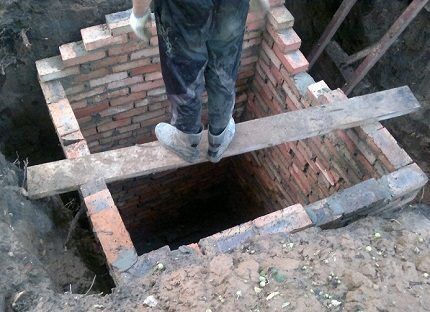
Technically, a drainage pit is the simplest septic tank or human waste storage tank. A sewer pipe leading from the house is connected to this tank, located underground.
The pipes of a separate toilet, bathhouse and other premises located on the site are also connected to it.
One common cesspool on the site is not the only option for organizing such a system. If desired, you can make a separate small container for each room.
This solution may be convenient, for example, if the bathhouse is located at a considerable distance from other buildings.
Waste is gradually accumulated and partially disposed of, depending on the type of structure. As the pit fills with wastewater, it must be cleaned to prevent the structure from overflowing.
Modern means allow waste disposal to be carried out with a fairly high degree of efficiency. We recommend that you familiarize yourself with the best practices for cleaning cesspools.
Types of cesspools
You can build any type of cesspool from brick:
- hermetic;
- with permeable walls;
- without bottom;
- divided into several sections.
Each building has certain characteristics. For example, sealed pit used in areas with high groundwater levels. This design prevents the possibility of environmental pollution by wastewater.
Permeable drainage pits, intended for the processing and disposal of gray waste, are installed with a meter-long sand and gravel filter in the bottom area.
If the throughput capacity of the underlying rocks is insufficient, they are equipped with small holes in the walls through which the liquid part of the waste is disposed of.
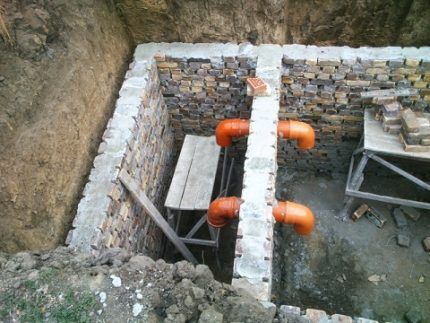
In the so-called pits without bottom the lower part is not concreted. The walls of such structures are erected on a concrete base with a gap, into which a sand and gravel filter is laid directly on the ground.
Liquid effluent will slowly percolate through this natural filter and then enter the underlying soil strata where it undergoes final treatment. The use of brick allows you to create both a sealed drainage pit and a permeable version. Most often, such structures are made with a rectangular base; this is the simplest design.
Divided into several sections. A large pit can be divided by partitions into two or three sections, which are connected by overflows.
Such a device, similar to a sewer septic tank, allows you to repeatedly separate the bulk of solid and liquid waste and increase the degree of their processing with the help of bacteria.
Features of a brick structure
Using brick to build the walls of a cesspool has a number of advantages. This material perfectly holds impurities and is durable. Using brickwork you can create a structure of any size and configuration.
When using concrete rings, you have to adapt to their standard dimensions. Pouring monolithic concrete is no less labor-intensive than laying bricks.
It is not necessary to use high-quality material for the cesspool; bricks that have already been used before will also work.
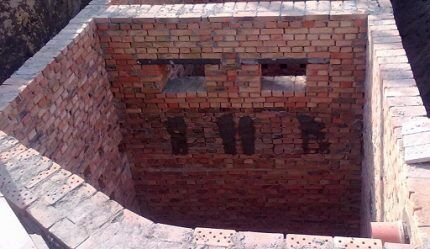
Masonry work requires certain skills; it is a real art of construction. It is best to master such operations during the construction of sewerage structures, since all the flaws will be hidden underground in the future.
And yet you shouldn’t do the laying completely carelessly. An uneven brick wall may collapse over time.
A brick storage tank has one useful property - it is stable at almost any groundwater level and has good resistance to swelling of the soil when it freezes in winter.
Such a drainage pit can be constructed both on light sandy soils and on heavy clay soils.
Useful recommendations for building a brick pit are given in the following photo selection.
An example of constructing a pit for a shower and toilet
As an illustrative example, consider the example of constructing a brick pit to receive wastewater from a country shower and toilet. This decision is justified by the small dimensions and the inability to arrange objects separately.
The pit itself will be located under the toilet, and a drain will be led into it from the shower room.
The main work has been done. Now we need to pour concrete into the formwork and install vital sanitary and hygienic facilities:
It is better to sheathe the shower frame with waterproof material, for example, cellular or monolithic polycarbonate, or plexiglass. Any particle or fiber boards, boards and similar materials are suitable for lining the toilet.
Subtleties of building a brick pit
Before starting work, you need to decide on the size of the future cesspool, as well as find a suitable place for the construction.
Stage #1 - preliminary calculations
The simplest calculation option is based on the average standard. The number of people permanently living in the house is multiplied by the norm of 0.5 cubic meters. meters.
After this, you need to calculate the parameters of the cesspool depending on its configuration. The container is usually made in the form of a cube or cylinder. The first option is preferable, since it is easier to line a container with straight walls with bricks.
The depth of the pit should be no more than three meters, but practice shows that it is possible to service a sewer with a depth of less than two meters or less. The volume of the pit now needs to be divided by the selected height. The resulting figure will be the area of the base.
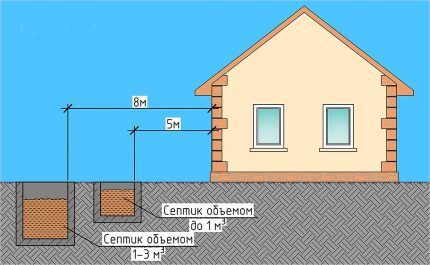
It remains to choose the length and width for a container with a rectangular base. If you decide to dig a cylindrical hole, you will have to use the formula for the area of a circle:
S=πr2
Where:
- S - area of the structure;
- π - number “pi” equal to 3.14;
- r — radius of the structure.
The resulting area should be divided by 3.14, i.e. to the number "pi".From the result, which is the square of the radius of the circle, you need to extract the root, obtaining the actual radius of the base of this cylinder.
Before marking, all parameters must be increased by the size of the brickwork and concrete base. This role is usually performed by a concrete slab 30-40 cm thick.
The concrete screed should have approximately the same dimensions. The thickness of the brickwork for sewer structures should be 25 cm on the outer contour, and 12-13 cm is sufficient for internal walls.
When choosing the parameters of the container, you should remember that filling it more than two-thirds is undesirable, so the depth of the pit for the cesspool should be increased to the required size. When choosing a location for a structure, a number of sanitary standards should be taken into account.
For example, the distance from a sewage storage tank to a residential building must be at least five meters, to a fence - at least two meters, to a source of drinking water - at least 25 meters, etc.
In addition, in areas with uneven terrain, sewerage devices should be located lower than the water source. Finally, it is necessary to provide access for sewage disposal equipment.
The machine does not have to be in close proximity to the cesspool, but the distance between them should not exceed a limit of four meters.
Stage #2 - excavation work
Once the markings have been completed, you can begin digging a pit. The easiest way is to order the services of an excavator, but if you need a small capacity and want to save money, you can do it manually.
The technology of work is very simple: the ground is dug with a bayonet shovel, and as the pit deepens, it is removed using a bucket on a rope.A ladder will be useful to get out of the hole, as well as a regular building level to control the quality of the work.
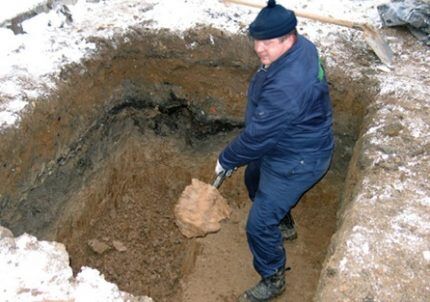
The walls of the pit are usually made vertical, but the bottom is given a slight slope so that the contents of the container accumulate in the corner, above which the maintenance hatch will be located.
In the future, this point will make it easier to pump waste out of the container. On light soils, the walls may need to be protected from crumbling, for example, with the help of temporary wooden structures.
Stage #3 - installation of a concrete base
If the bottom of the pit is supposed to be made airtight, then either a concrete slab must be placed down or concreting work must be done. In the first case, everything is simple: choose a reinforced concrete structure of suitable dimensions and install it below.
If the decision is made to concrete the bottom, then first a sand cushion about 15 cm thick is laid down. The sand must be leveled and compacted, observing the previously made slope.
Then a reinforcing mesh is placed on the bottom and a cement-sand screed is poured. After this, you need to wait until the concrete base hardens.
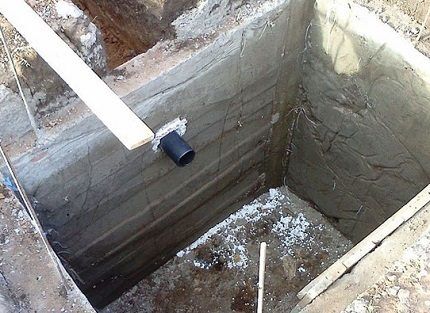
It takes about four weeks for it to dry completely, but when constructing a cesspool, work usually continues seven days after the base has been poured.
If you plan to build a cesspool without a bottom, you should fill only the space above which the walls will be built with a concrete screed.
Open ground is left in the center, on which a sand and gravel filter is subsequently laid. To properly fill the concrete base in this case, you will need to build wooden formwork.
Stage #4 - making brickwork
For a cesspool, it is recommended to use durable red ceramic bricks, but white silicate bricks are also considered quite suitable.
To prepare masonry mortar you will need the following ingredients:
- cement grade M400 - 1 part;
- construction sand - 3 parts;
- water - 0.8 parts;
- slaked lime or clay - 0.5 parts.
Sand and cement need to be sifted so that there are no solid inclusions, this will make the solution homogeneous and bring it to the consistency of liquid sour cream.
First, a clay castle is made on the base, and the first row of bricks is placed on it. The masonry is immediately leveled using a level. The thickness of the clay castle will be uneven, since the bottom is made with a slope.
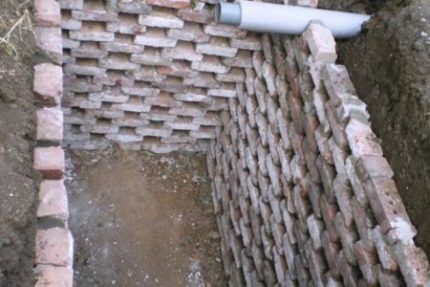
First, beacon bricks are placed in the corners and their position is carefully leveled. Next, the laying is carried out using rope beacons, which are pulled for each row.
Experienced craftsmen can lay three rows at once or use a special ordering strip. Beginners are advised to first check literally every brick they lay with a level.
A plumb line is used to control the quality of the masonry vertically so that the wall is level.
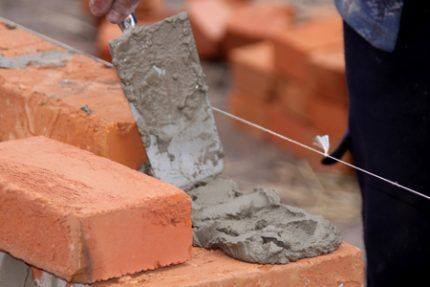
Depending on the thickness of the wall, a brick laying scheme is chosen.If you need to make a wall 25 cm thick, then lay it “in one brick”, and if it is 12 cm - “in half a brick”. The length of the brick corresponds to the width of the wall.
Of course, this is not how a permeable cesspool is made. Usually it is laid “in half a brick,” with gaps made between individual bricks so that liquid drains can escape through these holes.
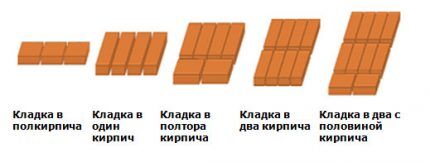
In any case, you should adhere to the rule: vertical seams between bricks in adjacent rows should not coincide. The laying is done as follows: a small amount of mortar is applied to the surface of the base using a trowel.
A brick is placed on top and pressed, gently tapping it with a trowel so that it takes the correct position.
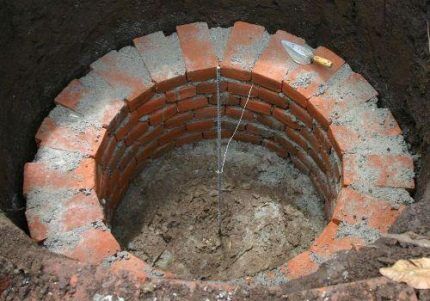
Then the excess solution is picked up with a trowel. There is another technology: the solution is applied to a separate brick, then it is installed in place.
Here are some useful tips for masonry work:
- The dimensions of the mortar-filled joint between the bricks should be about 6-8 mm.
- The seam should be the same size everywhere, this will improve the quality of the work.
- Bricks should be placed along the walls in small portions to reduce work time (you won’t have to bring every brick from a common pile).
- Before laying, the bricks are watered, this improves the adhesion of the surface to the mortar.
- Every fifth row is recommended to be laid using a special reinforcement mesh.
Of course, a sewer pipe needs to be connected to the cesspool. The entrance site should be thoroughly treated with the solution to avoid leaks.
The pipe must be properly insulated and laid below the freezing level of the soil, maintaining the required slope. We recommend looking at detailed information about the material for insulating sewer pipes In this article.
After the masonry work is completed, the walls need to be plastered.
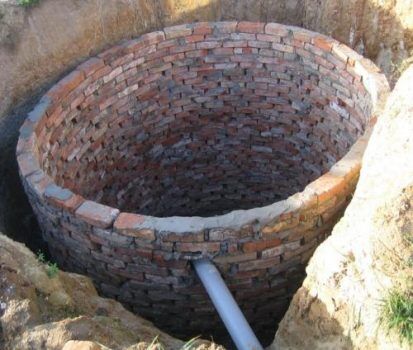
Stage #5 - waterproofing and top flooring
A layer of waterproofing material, for example bitumen mastic, is placed on the plaster. These measures will help extend the life of the sewer system.
When applying waterproofing materials, you must strictly follow the instructions. For example, mastic requires a dry base.
Now you can install the top floor. To do this, it is best to purchase a ready-made concrete slab with a hole and a cover - sewer hatch.
Alternatively, you can consider a self-made concrete structure or a timber floor. The latter option is no different in strength; such an overlap will have to be replaced every few years.
If you decide to make a concrete floor yourself, you should start making it simultaneously with the base and using a similar technology. Pouring is done into wooden formwork.
The parameters of the upper ceiling must exceed the dimensions of the hole that it will cover by at least 30 cm.
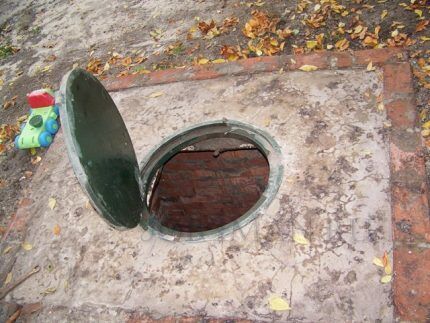
First, a layer of mortar of several centimeters is poured, then the reinforcement is installed and the main layer is poured. This element must dry within four weeks. It is necessary to make another hole in the upper ceiling - a ventilation hole.
The sewer system needs proper ventilation, because over time, wastewater begins to release methane, which is a dangerous gas.
To organize natural ventilation, use a plastic pipe with a diameter of about 100 mm. The top of the pipe is covered with a protective device; it also wouldn’t hurt to equip its lower part with a grill.
After installing the ceiling, a layer of waterproofing should be applied over the structure; roofing material or even thick polyethylene film will do.
A soil and plant layer is usually laid on top to improve the area and protect the cesspool from freezing in winter.
Features of device operation
Basic care for a cesspool comes down to emptying and cleaning it in a timely manner. Significant assistance in the recycling and disposal of waste can be special bacteria, intended for cesspools.
Such drugs are usually provided with detailed instructions and are very easy to use. They need to either simply be poured/poured down the drain, or pre-mixed with some water.
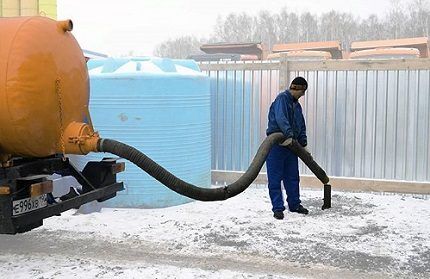
Such microorganisms are able to process wastewater, decomposing it into safe components.At the same time, the smell characteristic of sewerage devices disappears.
But it should be remembered that contact with some types of household chemicals is destructive for bacteria, so you will have to check the composition of the washing and cleaning products that are available in the house.
After the cesspool has been cleaned, it does not hurt to inspect it and check the integrity of the brick walls. If necessary, carry out minor repairs to the structure: replace damaged bricks with whole ones, restore damaged waterproofing, etc.
In addition to bricks, concrete rings, tires, a barrel, etc. can serve as materials for making a cesspool.
Detailed guidelines for making a cesspool from various types of materials can be found in the following articles posted on our website:
- Cesspool from a barrel: a step-by-step master class on arrangement
- How to build a cesspool from concrete rings: diagrams + step-by-step guide
- How to build a cesspool from tires: step-by-step technology for self-construction
- Plastic cesspool: how to choose a container and properly arrange a plastic pit
Conclusions and useful video on the topic
The process of laying bricks when creating a permeable cesspool is clearly presented here:
This video describes the process of creating a cesspool in an area with high groundwater:
A brick cesspool is a reliable and convenient structure. Making such a device is not easy, but all efforts will pay off, since if the technology is followed, such a device can last for many years.
Do you use a self-made brick pit as a waste storage tank? Or are you just planning to build a cesspool? Maybe you still have questions after reading this material? Ask them in the comments to our article - we will try to clarify the difficult points.




Now I am building a cesspool out of brick. And I already regretted my choice, it would be better to make a mine from concrete rings, it would be faster. I've been working on the hole for two months now and can't finish it. I can only reassure myself that a sewer well with brick walls will last longer. The brickwork is ready, all that remains is to connect the pipe, plaster and cover it. I will try to finish it in two weeks.
I made my own drainage well. If you are going to make it out of brick, then do it yourself. I am a mason myself and therefore laid out the masonry with my own hands. I still have some brick left over from dismantling an old garage (still Soviet). This is what I mean: it will be a little expensive if you hire someone from outside and pay it out. And brick is not cheap. I would advise digging a hole, putting internal formwork and everything in concrete. This is the best option for me. You can also quickly build from ready-made concrete rings. And everything is specifically described on the website.